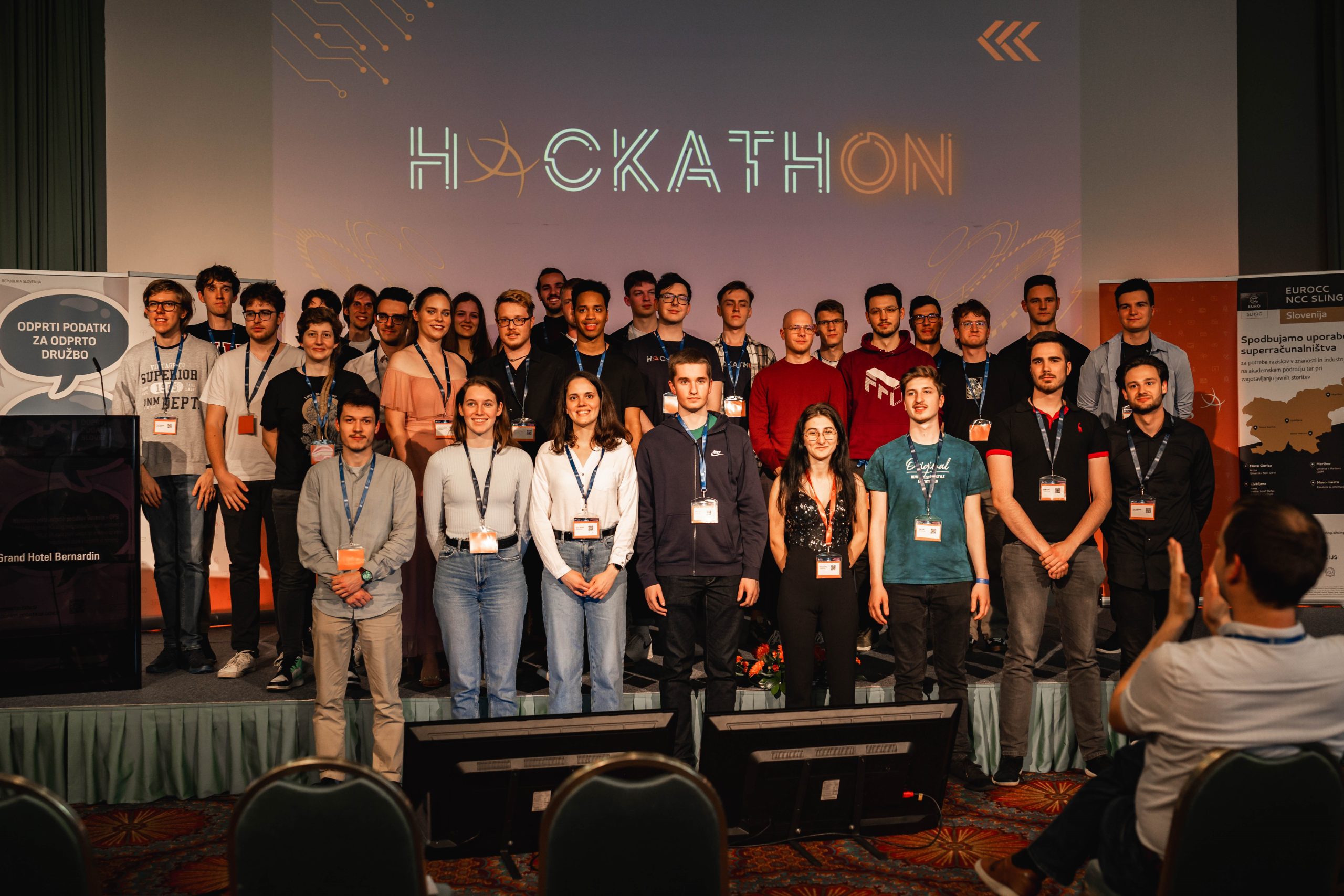Winners known for the Arnes HackathON, challenges solved by 40 students in 10 teams
The second, 24-hour round of the first Arnes all-Slovenian HackathON took place on 13 and 14 May in Portorož as part of the Days of Slovenian Informatics conference.

Under the slogan “Help shape the future through open science” the first Arnes all-Slovenian HackathON saw more than 70 students from across Slovenia compete to solve current and salient issues, with 40 of the students placing in the final round.
First place goes to the team IDealni Scenarij for a data management solution
The expert committee had a very hard job, since it was not easy to select the best out of the multitude of outstanding projects. The winning team with the name IDealni Scenarij, composed of Alen Cigler, Ruben Ferreira, Hana Skitek, Erazem Stanonik and Jana Volk, presented a solution for the efficient management, sharing and use of data without risking the security, privacy or integrity of the data. Their system standardises and regulates the method of managing, sharing and using data, thereby removing existing obstacles for the effective exchange and use of data and enabling individuals, companies, research organisations and government institutions to explore the new opportunities offered by modern technology.
Second place was taken by Filip Štamcar, Nik Pirc and Matija Derganc from the group Kenguruji, who came up in 24 hours with a way to improve the flood prediction model by means of which they created a new flood map of Slovenia. They compared the data with the existing flood control infrastructure and they showed the data of the estimated water level relative to the weather forecast on a website.
In third place at the competition were the members of the group Rudarji znanja (Miners of Knowledge), Blaž Erzar, Haris Kupinić, Luka Salvatore Pecoraro, Jaša Samec and Jovana Videnović, who created the žARKO project, which by means of photographs and other data captures recognises short-term radiation, predicts the amount of energy generated by solar power plants and identifies faults or the deficient functioning of cells due to dirt. All three teams based their work on data available on the Open Data Slovenia (OPSI) website, and the second and third-placed teams also used data from the Slovenian Environment Agency ARSO.
BliskBus the best at solving the challenge from Sandoz | Lek
The sponsor’s challenge from Sandoz | Lek was focused on the processing of natural language and large language models in labelling medicines and instructions for use. Competitors had access to the company’s exclusive databases and to data from the Central Medicines Database, the Rules on labelling and to the instructions for use, along with data on the OPSI website. The prize for the best solution went to the team BliskBus, composed of Iva Černoša and Neo Xander Kirbiš.
Vote for the public choice of the best Arnes HackathON solution
You now have the chance to cast your vote for the best team or presented solution. The team with the most votes will receive a prize and commendation.
You can vote just once, and you have until 3 June.
You can check out all the presentations on the Arnes Video website, on the Arnes HackathON channel, and you can vote for them in the survey on the service Arnes 1KA.
We link knowledge with cooperation, experience and professionalism
The Arnes HackathON is co-organised by the Slovenian Informatics Society, the OPSI portal, which is administered by the Ministry of Digital Transformation and the Ministry of Public Administration, the Faculty of Computer and Information Science at the University of Ljubljana, the National Competence Centre for Supercomputing EuroCC SLING and the Slovenian Open Science Community. The event took place under the patronage of the Slovenian National Committee for UNESCO.
Indispensable data, experience and expertise for the HackathON were also shared by the Jožef Stefan Institute, Slovenian Environment Agency (ARSO), Maribor Institute of Information Science (IZUM), Clarin.si, Centre for Language Resources and Technologies (CJVT) and the Institute of Contemporary History.
Expert help and support for competitors in the HackathON came from mentors and a committee from the various fields addressed by the HackathON. In this way we collaborated with Ana Slavec (UP FAMNIT and InnoRenew CoE), Jani Pogačar from the Faculty of Information Studies in Novo Mesto, Marina Rajič from the Ministry of Digital Transformation, Alenka Pšeničnik from the Ministry of Public Administration, Slavko Žitnik and Damjan Fujs from the UL Faculty of Computer and Information Science, Sergeja Masten from the Archive of Social Science Data (ADP), Gašper Hrastelj from the Slovenian National Committee for UNESCO and Samo Stanič from the University of Nova Gorica, coordinator of the Slovenian supercomputer network SLING.
Equally, the event would not have been possible without financial sponsors who contributed to the cash fund for attractive prizes: Ministry of Digital Transformation, Sandoz | Lek, Modra Zavarovalnica.
New challenges in 2025 with open data and supercomputers
Due to the great interest and successful implementation, we will repeat the event in 2025, with new challenges, more sponsors and an even more diverse programme, since we wish to present open science, open data and supercomputer capacities as a fundamental array of work in the research world and also in the business sphere.